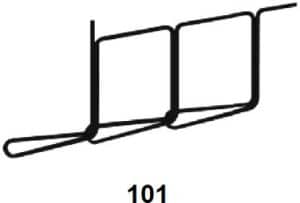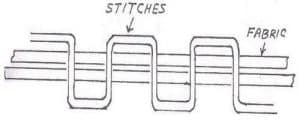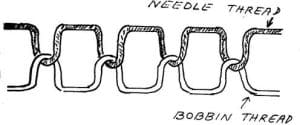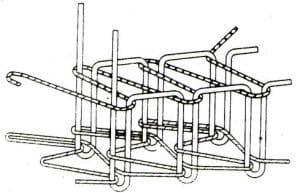Introduction Types of stitches
Seam and stitch are interdependent. Stitches cannot be made without a seam. A seam is the connection between two or more layers of material. Seams are usually created by sewing, which involves joining one or more threads or loops through interloping, interloping, or interlacing. A stitch is the basic unit of sewing.
A stitch is formed by interloping, interloping, or interlacing one or more seam line threads. Intralooping happens when one thread loop is passed through another loop of the same line. Interlacing happens when one loop of a thread passes over another loop of another thread.
Objectives of different types of stitches
- Differentiate between various types of stitches
- Observe the formation and structure of stitches
- Know about the uses of multiple types of stitches
different types of stitches classification
In the Stitch glossary, About 70 types of stitches are found, and from these types, 18 to 20 types of stitches are mostly used in the garment industry. All types of stitches are classified into six classes. They are
- Stitch class-100 : Chain stitch
- Stitch class-200 : Hand stitch
- Stitch class-300 : Lock stitch
- Stitch class-400: Multi-thread chain stitch
- Stitch class-500: Over edge/Edge neatening chain stitch
- Stitch class-600: Covering chain stitch
Stitch class-100: Chain stitch
Chain stitches are created by one or more needle threads and are characterized by interloping. The process involves passing a needle thread through the fabric, forming a loop, and securing it with the following loop created by the same thread. This makes a stitch. However, this type of stitch could be more secure, and if any stitch breaks, it can quickly unravel. The most common type of chain stitch is stitch class 100, stitch type 101. Due to its lack of security, it is mainly used for temporary stitching operations like positioning collars, cuff flaps, and other similar items during blasting operations.
Sketch:

Stitch class-200: Hand stitch
This stitch originated from hand-sewing with a single thread. It’s secured by passing the thread in and out of the fabric. Stitch type-209 is used on jacket edges, made with a special needle and sewing machine. It’s commonly found in high-end dresses due to its durability and polished appearance.
Sketch:

Stitch class-300: Lock stitch
Interlacing groups of threads create this stitch. One group is the needle thread, and the other is the bobbin thread. The lock stitch is strong, secure, and has the same appearance on both sides. However, the bobbin contains less thread and needs to be threaded again, which is time-consuming. Lock stitch is used for joining fabrics, collars, cuffs, pockets, facing, etc. Top stitching is used for buttonholing, attaching, blind stitching, etc.
Sketch:

Stitch class-400: Multi-thread chain stitch
This stitching technique involves two or more groups of threads – needle thread and looper thread. The loops of one group of threads are interlaced and meddled with the material and secured by the loops of the other group to create stitch type-401. This stitch is commonly used in jeans and trousers and significantly reduces the possibility of seam pucker. To avoid running out of thread, all threads used in this stitching technique are supplied from cone packages.
Sketch:

Stitch class-500: Over edge/Edge neatening chain stitch
This stitch class is formed by using one or more groups of threads. At least one thread group passes around the edge of the material to prevent any thread from coming out of the fabric. This class’s most commonly used stitch comprises one or two needle threads and one or two looper threads. This stitch type creates a narrow strip of stitching along the edge of the fabric. Before sewing, a trimming knife is used to ensure a tidy edge.
Stitch type 504 consists of a needle thread and two looper threads. This stitch is ideal for neatening edges and creating seams in knitted fabrics. It has excellent extensibility, and the width of the stitch is usually between 3-5 mm. This stitch type is also suitable for creating decorative edges with a needle.
Sketch:

Stitch class-600: Covering chain stitch
The type of stitch discussed here is created using three groups of threads. Two groups of threads are visible from both sides of the fabric. The first group is called the needle thread, the second is the top cover thread, and the third is the bottom cover thread. These stitches are very intricate and require up to nine threads to produce. One example is stitch type 606, which requires four needle threads and five other threads and is known as a flatlock stitch. Flatlock stitches are often used in undergarments and leisure wear for decoration. On the other hand, stitch type 602 is used to attach laces, braids, and elastics to garments, as well as for decorative stitches and topstitching.
Sketch:

Conclusion
We learned about various thread types and the associated parameters of different types of stitches. It will enable us to make informed decisions when selecting thread materials. We sincerely thank our teacher for guiding us through this experiment.
Also Read: 8 Different Type Of Seam In Garments Industry With Picture
FAQs (Frequently Asked Questions)
What are the 4 basic stitches?
The four basic stitches commonly referred to in sewing are:
1. Straight Stitch
2. Backstitch
3. Running Stitch
4. Zigzag Stitch
How many types of stitches Class are there?
There are 6 types of stitches used in sewing, each serving different purposes.
Stitch class-100 : Chain stitch
Stitch class-200 : Hand stitch
Stitch class-300 : Lock stitch
Stitch class-400: Multi-thread chain stitch
Stitch class-500: Over edge/Edge neatening chain stitch
Stitch class-600: Covering chain stitch


